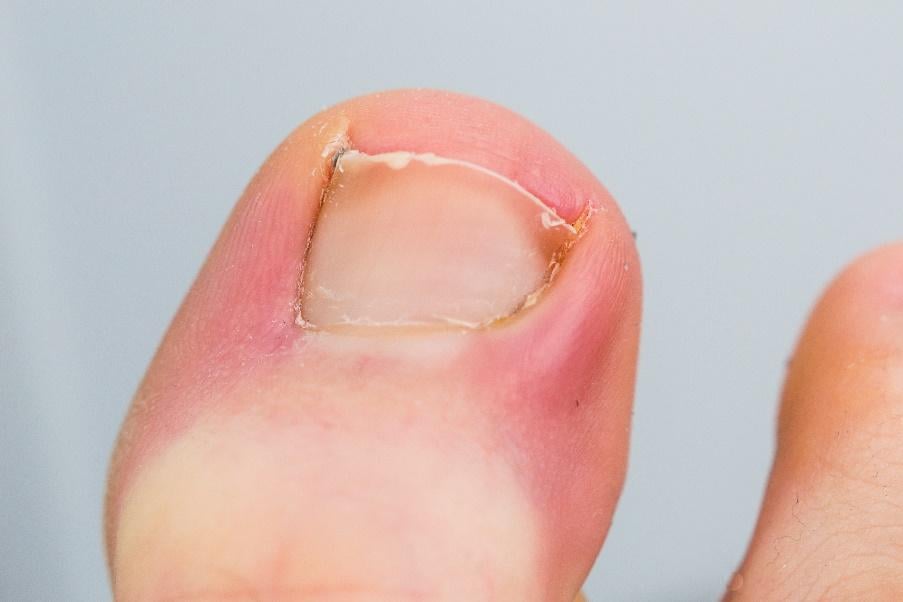Ingrown Toenails at Westbourne Centre
An ingrown toenail occurs when the edge of a toenail grows into the surrounding skin, leading to pain, swelling, redness, and sometimes infection. It’s a relatively common condition that most often affects the big toe, typically on one side, though it can develop on other toes or both sides of the nail.
Ingrown toenails can sometimes be managed at home, but it’s often safer and more effective to seek professional treatment – especially if the area is infected, very painful, or the problem keeps coming back.
Below, we explain what causes ingrown toenails, how they can be treated, and how to help prevent them.
What is an ingrown toenail?
An ingrown toenail happens when the front corner or edge of the nail grows downwards into the skin beside it. In mild cases, only the tip of the nail pierces the skin, but in more severe cases, a larger portion of the nail curves downward, pressing deeply into the surrounding tissue.
Ingrown toenails typically affect the big toe, often on just one side, though they can occur on both sides or other toes. They usually cause mild to moderate pain and swelling, but if the area becomes infected, symptoms can worsen – potentially making it difficult to walk and increasing the risk of complications.
The most common cause is improper nail trimming, particularly rounding the edges too much. Other contributing factors include poorly fitting footwear, toe injuries, or naturally curved toenails.
What does an ingrown toenail look like?

What causes an ingrown toenail?
Ingrown toenails can be caused by a single factor or a combination of issues. They’re usually brought on by:
- Improper nail trimming – cutting nails too short or rounding the edges can encourage the nail to grown into the skin (this is the most common cause)
- Tight or poorly fitting footwear – shoes that put constant pressure on the toes can push the nail into the skin
- Injury or trauma – stubbing your toe or repeated pressure from activities like running can lead to nail changes
- Nail or skin infections – can alter nail growth patterns or cause swelling that leads to ingrown toenails
- Medical conditions – such as diabetes, poor circulation, or nerve damage, which can increase the risk of complications
- Genetics – naturally curved toenails or the natural shape of your toe may make you more prone to ingrown toenails
What are the symptoms of an ingrown toenail?
An ingrown toenail typically develops when the edge or corner of the nail grows into the surrounding skin. The most common symptoms of an ingrown toenail are:
- Pain or tenderness along one or both sides of the toenail
- Redness and swelling around the affected area
- Skin that feels warm to the touch
- A throbbing or aching sensation
- Signs of infection, such as pus (which may be clear, yellow, or crusty when dried)
If you notice the nail digging into your skin – especially alongside any of these symptoms – its likely you have an ingrown toenail. Infected or persistently painful ingrown toenails should b assessed and treated by a healthcare professional.
What are the stages of an ingrown toenail?
Ingrown toenails are often described in stages, based on how severe the symptoms are. These stages can help indicate when professional treatment may be needed.
Stage 1 (Mild)
The skin around the toenail is red, tender, and slightly swollen. Discomfort is usually mild and felt mainly when pressure is applied. At this stage, there’s typically no infection, and home care – such as soaking the toe in warm, salty water and gently lifting the nail edge – can often resolve the issue.
Stage 2 (Moderate)
Redness and swelling increase, and the area becomes more painful. The skin may begin to break down, with possible clear fluid drainage – a sign of early infection. Walking may become uncomfortable, and if symptoms persist, medical treatment may be needed.
Stage 3 (Severe)
The toe is significantly swollen, red, and painful. Infection is present, with pus or yellow-green discharge. Granulation tissue (new, overgrown skin) may develop around the nail. Without treatment, the nail and surrounding skin may become deformed. Professional intervention is usually required, which may include partial or full nail removal.
How an ingrown toenail is diagnosed
Because ingrown toenails often have visible symptoms, many people recognise the condition themselves based on how the toe looks and feels.
Even so, if you suspect you have an ingrown toenail, it’s a good idea to have it formally diagnosed by a medical professional – especially if the area is painful, swollen, or showing signs of infection. A GP or a foot specialist, such as a podiatrist, can usually confirm an ingrown toenail with a simple physical examination and by discussing your symptoms.
Ingrown toenail treatment
Some ingrown toenails can be managed at home, while others may require professional treatment or minor surgery.
How to treat an ingrown toenail at home
If your ingrown toenail is mild and not infected, a healthcare professional may recommend trying home treatment first. In some cases, as the nail continues to grow, it may naturally move out of the surrounding skin with proper care.
To help try and get rid of an ingrown toenail yourself, you can try:
- Soaking your foot in warm, salty water twice a day to soften the skin around your ingrown nail and help prevent infection
- Keeping your foot clean and dry between soaks
- Gently lifting the edge of the nail away from the skin, using clean cotton wool or dental floss (replace daily and only if it can be done comfortably)
- Applying an antibiotic cream to the affected area
- Covering your toe with a clean bandage
- Wear open or loose-fitting footwear to avoid pressure on the toe
- Taking over-the-counter pain relief such as paracetamol or ibuprofen if needed
How to remove an ingrown toenail
You should never attempt to remove an ingrown toenail at home. Doing so may worsen the condition or lead to infection. If home treatments don’t work or symptoms get worse, seek medical attention from a healthcare professional. Only a GP or podiatrist will be able to perform an ingrown toenail extraction or removal operation.
Ingrown toenail surgery
If you’ve not been able to treat your ingrown toenail at home, or if your symptoms have worsened, surgery may be recommended.
A healthcare professional might first try conservative treatments, such as lifting or taping the nail, or inserting a small splint.
In more persistent or severe cases, minor surgery is often required. This is a quick procedure usually carried out under local anaesthetic, with minimal recovery time and low risk of complications. Sedation may be available if preferred.
Depending on the case, part or all of the toenail may be removed, and in some cases, a small portion of surrounding tissue may also be taken away to prevent recurrence.
When to see a doctor about an ingrown toenail
In some cases, it’s important to seek medical advice promptly – especially if you have a condition that increases your risk of complications. You should see a doctor straight away if you have:
- Diabetes
- Reduced blood circulation
- Nerve damage in your feet
- A current nail or foot infection
- Any condition that affects wound healing
For others, it’s best to see a healthcare professional if:
- Your symptoms don’t improve after a few days of home treatment
- Your ingrown toenail symptoms, like pain, swelling, or redness, get worse
- You think you have an infected ingrown toenail
How to prevent ingrown toenails
If you’ve had an ingrown toenail before or want to reduce your risk, there are simple steps you can take to help prevent them:
- Cut your toenails straight across – avoid rounding the corners
- Don’t cut your toenails too short
- Softening your toenails in warm water before cutting them to make sure they’re easy to trim
- Wear shoes that fit well and don’t put pressure on your toes
- Keeping your feet clean and dry, especially if you’re prone to infections
- Protect your toes from injury during sports or physical activity
If you’re unsure about the best way to care for your feet, a podiatrist can offer personalised advice and help you reduce the risk of recurrence.
Choose Ramsay Health Care UK for your ingrown toenail surgery
If surgery is needed for your ingrown toenail, you can trust Ramsay Health Care for high-quality, patient-focused care. Our team of highly trained medical professionals ensures you receive the best possible treatment in a comfortable and supportive environment across our hospitals nationwide.
Contact us to find out more about ingrown toenail treatment with Ramsay Health Care UK.


